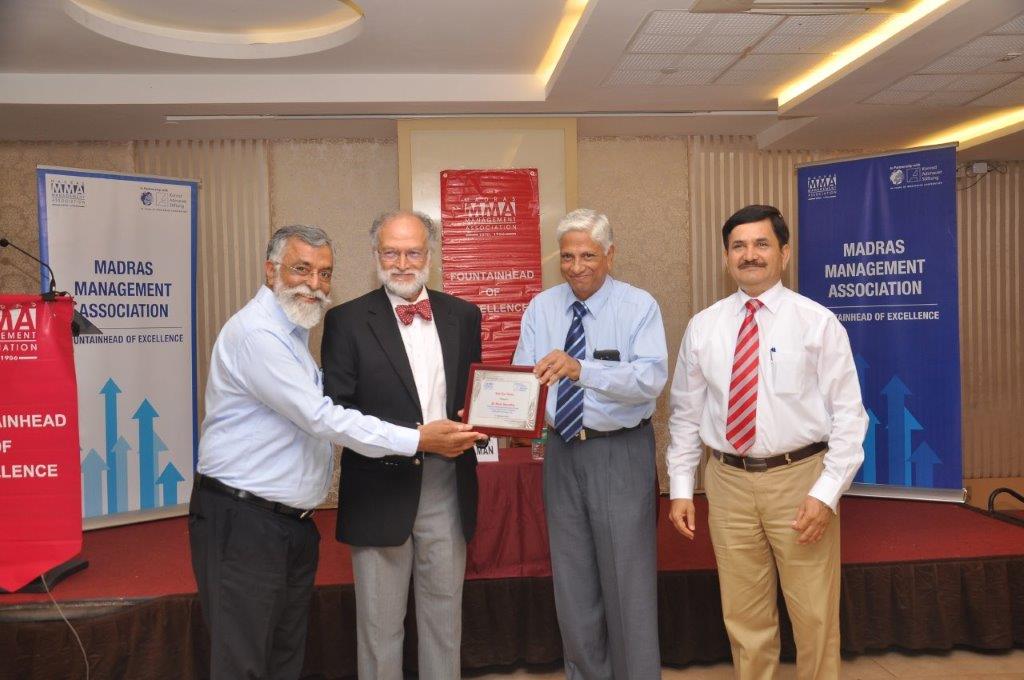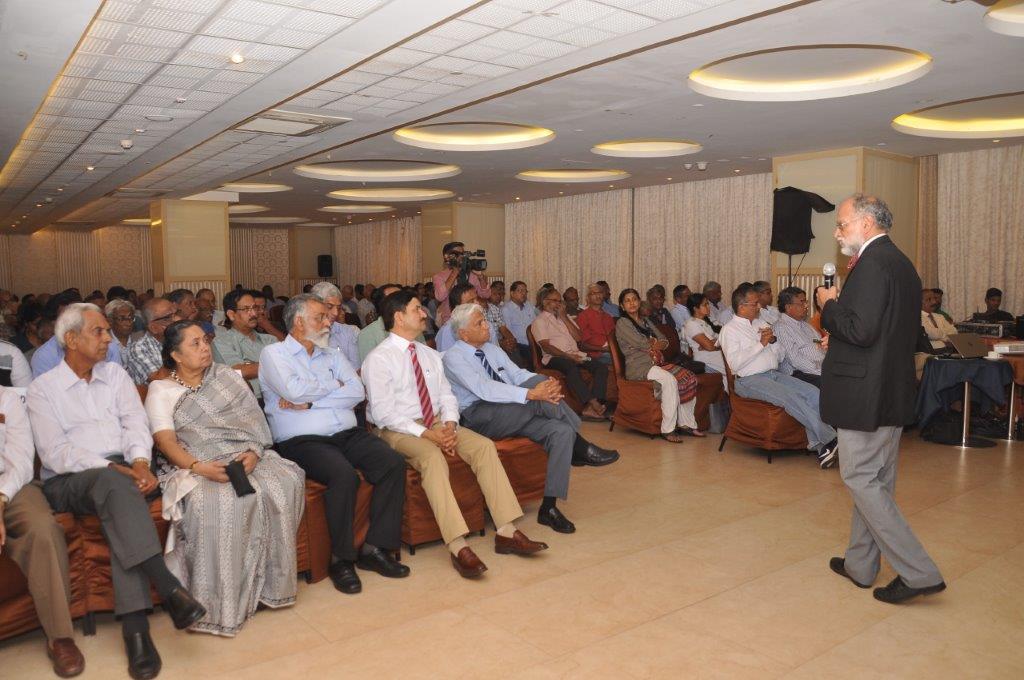Chennai Chapter: Building Family Business Dynasties

Building Family Business Dynasties: Ensuring Family Business Continuity across Generations
– Anusha S (PGP2006) and KC John (FPM1988)
Dr. Ravi Sarathy [PGP1968 Gold Medalist], Professor of International Business and Strategy, D’Amore-McKim School of Business, Northeastern University, Boston gave a very insightful presentation on ‘Building Family Business Dynasties: Ensuring Family Business Continuity across Generations’ on Thursday the 8th February 2018 at E Hotel, Express Avenue Mall, Chennai at 6:00 PM. About 80 alumni from IIMA and Madras Management Association [MMA] members attended the event. The Chennai Chapter partnered with the MMA to host the event.

Key Takeaways:
Family Business is common in countries like, India, China and across Latin America. The businessmen who started business needed families to provide them the capital and people who were trust-worthy. The challenge for all founders is to ensure the continuity of their family businesses across multiple generations. It is important to appreciate the duality of family business – a family business can only be regarded as successful, if both the business and the family are doing well across generations.
The key characteristics of a family business are family ownership, family involvement in management and intangible sense of a family’s long-term purpose embedded in the business values and operations.
The idea of creating legacy is inspirational for family business. The family businesses are not only about money, income and creating wealth. The family businesses have a sense of purpose. They have a vision of how they would like the family to be represented in society. A good family business that is intended to last for a long time has to be built both on the family values and long-term family goals that govern the business. Successful family businesses have long-term orientation, attention to non-economic considerations, social impact and so on. They want to do well, but they also want to a farce for good in the communities they operate in. Of course, the business needs adequate cash flow, in order to stay solvent as it realizes the long-term potential of its business. But as long as the business continues to operate as a going concern, it is only the long-term that matters for most family businesses.
Ensuring each family member’s continuing commitment to the business and to the family is very important to ensure long-term family business success. Family businesses are successful in part because a small number of key family members are able to make major business decisions. This allows for quick and flexible decision making, agility and flexibility in grasping new opportunities, and deciding to change the direction of the business when warranted. Such decisions are often made keeping in mind balancing short-term considerations with the long-term success objectives of the family firm.
Most often, the conundrum about family business is which comes first – ‘Family’ or ‘the Business’. Do you manage the business as successfully as you can, or do you run the business for the family to be successful? The true answer is that the business must be run for all stakeholders. The stakeholders include: the family members, employees, customers, regulators, and so on. Ensuring the success of the extended family stakeholders enables the building of a dynasty of the long-lasting family business.
There is a growing realization that it is better to be inclusive and to have a larger embrace of who will be considered family rather than excluding individuals because of narrow definitions. This is becoming truer with the current generation, particularly concerning where the daughter or the wife will fit in a family business. The distinction between families in terms of blood relations vis-à-vis marital family has started to blur. Marriage alliances are one important way of cementing relationships and alliances within the business community with other businesses, so that you have a partner that you can trust in the other business, and you have a source of additional human resources, high level managers to draw on who might become a part of your business.
Successful family businesses use multiple modes of communication transparently so that information is not hidden and are shared. This enables the family members to stay aware of why the business is important; how it is doing, and how one can contribute to the success. Face-to-face interactions among siblings and other extended family members are very critical in strengthening the family bonding.
There will be conflicts in any family business. It is critical to admit the existence of conflict. Otherwise, it will get worse. The sources of conflict could be many. A good example of a task-based conflict is, “You are not doing the job and that is why I as the business family founder is angry with you”. A relationship-based conflict is often continuance of past grievances between siblings or family members. Inter-generational conflict could often be due to a perception that senior generation is authoritarian.
One of the aspects of managing conflicts is fair process. Fair process is simply operationalized as “if you have a business with several participatory family members, they all needed to be treated fairly.” Each family member need not get the same rewards; but all family members should be judged using the same approach, and be given the same opportunities in terms of learning, training, and promotions. All things remaining the same, the future growth is contingent on performance and not because of differential treatment.
Each family needs a member champion in every generation, who is a leader, who has moral authority and commands the respect of other members of the family, and is therefore respected and trusted. Such a champion can act as a trusted mediator to resolve the conflicts and keep the family together. The champion’s stature can help her/him act as a change agent.
How do you prepare the family members to become part of the business? Socialization within the family is the interesting first step. The next generation members get to know about the family business through ‘grooming’. It can take different forms. As a teenager, one learns about the family business by simply being among the family members who are involved in the business. They talk about the business. As they grow, they may be asked to come and help on the inventory or sales, or testing a new product.
Education, training and internships are necessary to prepare the family members for the business. Outside experiences are very important, where one no longer have the insider privileges. Instead, one will be judged much more on who you are as an employee and manager based on one’s performance. A central aspect of the grooming of family members to become part of the business is to require them to work outside the family business for 3-5 years. So when they come back, they have proven that they can be successful elsewhere, and work with managers who may be critical or difficult to work with, which will give them an advantage when they join the family business. They become much more aware how businesses operate differently from one another, or perhaps realize how fortunate they are to be able to join the family business.
How does the next generation enter the family business? Prove that the nextgen deserve entry into decision-making position. Otherwise, family business suffers due to incompetent people in the business. Family businesses are replete with examples where the founders treat the business and family as separate. Successful founders cannot favor the family in business. Therefore, it is advisable to have a meritocratic evaluation, if possible, by someone who is not a family member.
In most large family businesses, as they grow, the proportion of non-family members could be 70-80 percent. How should non-family members be treated, without whom the business cannot be successful? As long as the founder wants to run a family business, keep the family and business separate and make sure that the focus is on equal treatment of both the family and non-family members.
When should succession planning begin? It takes a long while to identify the best family members who will be able to succeed. It takes time to groom someone to reach that kind of position. It is most probably a decade long process. So one need to design ways to provide tests to the prospective successor. If s/he is not successful in passing these tests, these challenges, you will know that you need to spread the net wider to identify potential successor. You would look for potential successors who can be independent, demonstrate new ideas, new ways of running part of the business and address growth challenges creatively.
Another issue in many emerging countries is that ‘the oldest is the most important’. It is not always true that the oldest is the best. How do you balance age and seniority? It depends on the culture of the family. If the family believes that the eldest should be given priority, then the culture cannot be easily changed. Then comes the Board approval; because the Board has a commitment to being more objective than the family members. If you involve the Board, particularly when you have independent outside Board members, then you are much more likely to give objective assessments for the various candidates and have much more ability to provide each of the potential successors with assignments by which they can prove their worth and have much more objectivity in ranking them and saying, “this is the person who we think can likely to be successor”. So it should not be an individual decision, but involve the Members of the Board, who after all have been chosen by the family members.
As part of the succession plan, one also has to find some role for the founder who relinquishes her/his position. You need to have an assignment that is suitable to his/her knowledge and ability, and at the same time something that does not make him/her feel unimportant.
What about those who get passed over? Succession is only one or two family members appointed as the CEO, the COO or CMO; what happens to the members of the family who are in the business and for whatever reason, after a meritocratic process, are passed over in the succession plan? Do they then leave the business? This should be a loss to the business, and harmful to the family. There are ways to get them to be still loyal and support the family business. That is also part of the succession planning.
How is ownership transferred across generations? Apart from financial and tax implications, there is the consideration of voting power. As ownership is transferred across generations, individuals end up with different size stakes. This implies that the person who holds higher share has higher voting power. This could be a source of inter- or intra- family disputes and difficulties.
It is critical to design an appropriate governance mechanism. Ideally, you separate family from business. A Family Council that meets regularly discusses the various family needs, and every family member will have one vote in the Family Council, irrespective of larger ownership stakes. Because within the family everyone is equally important and within the family all members should have equal voice in being able to judge how to grow the business and what are the ways the family is able to contribute to the business and interact with the business needs. This is very important, that the family negotiates some consensus, and accepts equality within the family, as opposed to one where ownership matters.
At the corporate Board level, and incorporate shareholder meetings, you can have votes in relation to the size of the shareholder stakes. You vote through the voting meetings and there is election to the Board and so on.
Of late, there has been surge in creation of family constitutions among family businesses in the USA, India, China and other countries. They hire experts; spend many months on the process to craft a family constitution. For instance, the GMR group in India took about 7years, drawing on a large number of experts, consultants and facilitators to draft their family constitution. The heart of the family constitution is guidance for the subsequent generations. The current generation, who are running the business, know what kind of business they are running and what their values are. Their concern is, 30 years from now, when grandchildren will be joining the business; they need to understand why we are together as a family and running a business. The Family Constitution is a way to pass on what the family thinks is important today, while also providing avenues for the future generations to rethink the constitution and revise it as they see fit, in response to a changing environment.




Sorry, the comment form is closed at this time.